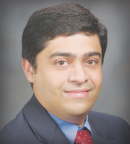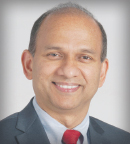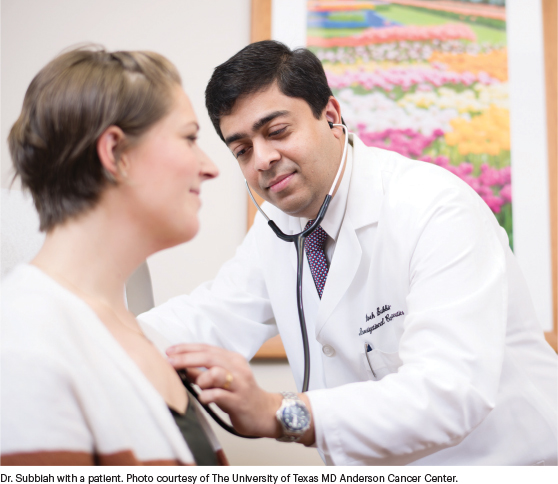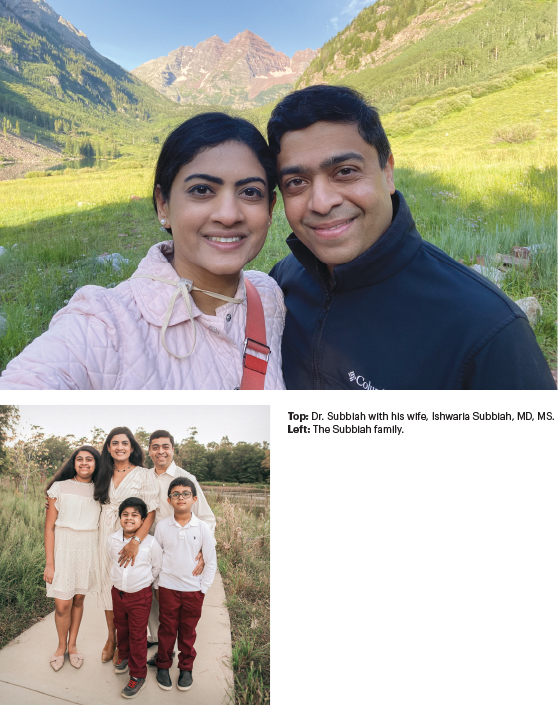In this installment of The ASCO Post’s Living a Full Life series, guest editor Jame Abraham, MD, FACP, spoke with Vivek Subbiah, MD, Center Clinical Medical Director of the Clinical Center for Targeted Therapy, Cancer Medicine Division, at The University of Texas MD Anderson Cancer Center, Houston.
Early Years
Please tell the readers about your early years, where you were born and raised.
I was born and raised in the south of India, in a city called Chennai, which is one of the major metropolitan cities in the nation. My dad was in banking, so he moved to many places, including Indonesia, but my parents made sure that my sister and I had a continuous education, so we stayed in the same place. My mom had a Masters in economics and a Masters in education; she motivated me to be a public speaker and inspired me to read and write a lot. My parents influenced my upbringing and helped me develop an independent thinking process that served me well all through school and into my career.
VIVEK SUBBIAH, MD

On being mentored by Emil J Freireich: “When I shared our research [that led to an FDA approval for a lethal form of thyroid cancer] with Dr. Freireich, he was impressed by the work but said I was just at the beginning. I’d extended life in these patients; now I had to strive for a cure. He truly motivated me to push the limits of research. That’s how advances are made.”
On the use of genomics in oncology: “I firmly believe that genomics is a powerful diagnostic tool that should be used universally. Even an untreatable disease warrants an accurate diagnosis.”
On artificial intelligence in medical practice: “It is important to make clear that AI will not replace physicians because the patient-physician relationship is one that is fundamentally impossible to mimic.”
On cancer research: “I think all cancers, rare or common, should be thought of as emergencies, and we should work together to create drugs to treat them. One of the main problems is that we all work in silos. We need to break up these silos so that we can work together as a team, to realize a true personalized vision in oncology.”
I went from kindergarten to 12th grade in the same school in Chennai and attended medical school in Chennai as well. It’s a beautiful beach town, home to the world’s second longest beach, called the Marina Beach.
Please talk a bit about other early influences and your educational journey.
My dad was a professor, an agricultural scientist when he started his career. But life as an academic was challenging, so he earned an MBA and moved into banking. There were no doctors in our small family. I was inspired by my grandfather, Prof. S.N. Chokkalingam, who was an academic and a renowned scholar. He studied at Oxford, worked in many countries, traveled widely, and wrote more than 120 books. He was instrumental in making me think about scholarly work, scholarly literature, service, and the need to contribute to society.
During my formative years—from first to eighth grade—I used to spend time with him on holidays, walking on the beach near where he lived. He would talk about fascinating things he’d been part of in his scholarly work around the world, from world history to English literature. The beach was studded with statues of famous personalities, scholars and philosophers. It was inspiring to hear him talk about all of them and make me read a lot about the life of those great people. Grandpa helped thousands of people with their careers, but he didn’t save lives. I thought to myself, I can probably help people with their jobs and livelihood, but a better thing would be saving lives and decided to go to medical school.
From India to the United States
Please describe your journey from medical school to postgraduate training.
I attained my medical degree at Sri Ramachandra Medical College and Research Institute, in Chennai. After medical school, I moved to the United States and completed a combined residency in Internal Medicine and Pediatrics at Case Western Reserve University, MetroHealth, Cleveland.
I was always fascinated by endocrinology and infectious diseases, but in my second year I met mentors at Case Western Reserve University, the Cleveland Clinic, and National Institutes of Health who inspired me to focus on oncology. Oncology is a fantastic science-driven specialty that combines exciting research opportunities with clinical care of our most vulnerable patients and combined all of the specialties that I was interested in. As an evolving discipline and with my interest in clinical trials, I could truly make a difference. Needless to say, it was a great decision.
MD Anderson Experience
Please tell us about your decision to pursue a fellowship at MD Anderson.
During my fellowship at MD Anderson, which was an amazing experience on multiple levels, I met three people who inspired my interest in clinical trials: the renowned Dr. Emil J Freireich; his mentee, Dr. Razelle Kurzrock; and Dr. Pete Anderson, who is now at Cleveland Clinic working in sarcoma. Like me, Dr. Anderson specialized in both medicine and pediatrics. So, it was nice to have someone to bounce ideas off, and he really motivated me to do research in academia. Dr. Kurzrock also had a major influence on my career, and at that time, she was forming this unique department for treating a patient independent of histology in the context of clinical trials.
As for Dr. Freireich, I got to know him really well because I was the fellow running the GME Lecture Series and he was the chair. We’d invite famous speakers from the who’s who in oncology and interact with them behind the scenes, before their talks. Dr. Freireich was sort of a grandfather figure to me who inspired me and focused my thought process toward a career in drug development and clinical trials. Later I became chair of the same GME committee that he was chairing. It was a special privilege.
Dr. Freireich used to call me to discuss novel therapeutic advances. Alternately, I used to share my latest research and clinical work with him—for example, research that I led in one of the most lethal cancers, anaplastic thyroid cancer, led to the approval of dabrafenib plus trametinib by the U.S. Food and Drug Administration (FDA).1 Up until then, we had no approved drugs for that disease. When I shared our research with Dr. Freireich, he was impressed by the work but said I was just at the beginning. I’d extended life in these patients; now I had to strive for a cure. He truly motivated me to push the limits of research. That’s how advances are made.
Tell us more about your early research.
My early research during my training was identifying novel drugs for Ewing’s sarcoma. I was fascinated by new drugs, and that steered me to a career in novel drug development. That was an exciting time when genomic sequencing entered the clinic, and both targeted and immunotherapy drugs were coming into the pipeline. I was drawn to the concept of doing something novel to benefit our patients rather than offering the same standard-of-care chemotherapeutic agents. Since then, I have designed and led several first-in-human trials and many precision oncology studies, starting with one of the first-ever basket studies, which was published in The New England Journal of Medicine and led to FDA approval for Erdheim-Chester disease.2
GUEST EDITOR

Jame Abraham, MD, FACP
Dr. Abraham is Chairman of the Department of Hematology and Medical Oncology at Cleveland Clinic and Professor of Medicine at Lerner College of Medicine.
Since then, our work led to another FDA approval in anaplastic thyroid cancer based on the ROAR basket study.3 Most recently, based on the ROAR basket trial, we were able to secure FDA approval for all BRAF-positive tumors in a tumor agnostic manner, and this is a major milestone in precision medicine. I also led the selective RET inhibitor studies that lead to FDA approval for both selpercatinib and pralsetinib for lung cancer, thyroid cancer, medullary thyroid cancer and tissue agnostic approval as well. I’m currently a principal investigator on more than 100 studies and have led many practice-changing trials like lurbinectedin for small cell lung cancer, pemigatinib for FGFR-altered cancers, among many others that have impacted thousands of lives globally.
One of the things Dr. Freireich stressed was that we can conduct all kinds of trials, but we need to answer the right questions so that the research benefits patients and is impactful in the real world. We can do trial after trial to answer some questions. The late Dr. Norman Jaffe used to say that randomized studies might get you a high impact paper and may be an answer, but they are not really going to help patients, especially those receiving placebo. These quotes really stuck in my head and inspired me to design studies that can directly help patients.
Drug Development, Genomic -Testing, and the Cost of Technology
Do you believe the drug development paradigm should be genomically driven?
Absolutely. The fundamental premise of oncology is that cancer is a genetic disease, and we need to arrive at the right diagnosis. So, genomic testing permits interrogation of the inside of the cell and definition of the tumor’s precise coding sequences. I firmly believe that genomics is a powerful diagnostic tool that should be used universally. Even an untreatable disease warrants an accurate diagnosis. We now have a phenomenal technology called next-generation sequencing, where we can peer into inside of the cells. We need to supplant centuries-old technologies of light microscope with this molecular microscope.

Our technology is evolving at a very rapid pace, and the precision oncology paradigm has completely changed the way we practice, giving our patients with cancer far better outcomes and more hope for the future. We have seen novel immunotherapy agents and genomically targeted therapy give extended quality of life to patients who only a decade or so ago had little hope of surviving beyond a couple of months. To be part of that scientific agent of change is incredibly rewarding.
How do we justify the considerable cost of genomic testing?
It’s a technology that needs to be thought of in a big-picture theme. We cannot guess which patient has these alterations; therefore, the first step is genomic testing. Some people argue that it’s not worthwhile if no clinical action can be taken. However, genetic alterations also predict prognosis. And even if we don’t have a drug today, it does not mean we cannot act and there won’t be a drug tomorrow.
The financial burden of cancer treatment is staggering, but genomic testing costs to obtain a complete diagnosis and to select appropriate therapy may be minuscule. It may be just a one-time event that in the long run leads to better, more cost-effective treatment and outcomes.
Personal Life
Please tell us more about your family and what you do outside of work.
My wife, Dr. Ishwaria Subbiah, is a medical oncologist. She trained at MD Anderson and is on the faculty here, specializing in supportive care and symptom control in the Palliative Rehabilitative and Integrative Medicine Departments. We have three children, one girl and two boys. We’re lucky to have family support to help with the children. We spend a lot of time on the weekends with the kids in Houston’s Museum of Natural History and other enjoyable and enriching activities. We also travel to other cities, where we delve into culture and art and visit national parks. My wife introduced me to the symphony and the opera.

Of course, I spend a lot of time with fellows and colleagues. All the former fellows have become faculty in many places, so it is always rewarding and inspiring to talk to them. Many of them have become friends, and they inspire me a lot. I also work with many young mentees who inspire me, too. They make me think harder and faster. My work and off-work activities seem to blend, creating a very rich and rewarding life.
Looking Ahead
What are your thoughts about the future of oncology?
I think this is the best of times to be in oncology. We are seeing the fruits of oncology research right now. People still need to understand that cancer is not one disease. It’s hundreds and thousands of diseases. And even common diseases are now being divided into rarer and rarer subsets.
The American Cancer Society recently released updated cancer statistics, and as a result of human papillomavirus (HPV) -vaccinations, we saw a 65% reduction in the incidence of cervical cancer. This follows the timeline of when HPV vaccination was introduced, and that vaccine can prevent five cancers. We’ve seen how smoking cessation programs have impacted the rate of smoking and lung cancer. Colorectal cancer screening is yet another huge success. I’m hopeful that in the future, we will devote more resources and energy to cancer prevention. Genomics can certainly play a major role in that initiative.
I recently published a paper in Nature Medicine,4 a forward-looking vision of clinical trials. People say it takes 10 to 15 years to develop a drug through clinical trials. Our work on the selective RET inhibitor, right from the first-in-human trial all the way to its FDA approval, took us about 3 years. So, this can happen even in small biomarker-driven diseases. And I think with artificial intelligence (AI) technology, every phase of drug development can be shortened. We need to use AI technology as augmentative intelligence technology to assist us with every phase of drug development. Every cancer can be subdivided into rarer and rarer biomarker-defined diseases. That process will greatly expedite drug development and life-saving therapies for our patients with cancer.
We have a long way to go. Each of us in the oncology community needs to think that it can be done. For example, the COVID-19 vaccine went from discovery to phase III trials to emergency use authorization in less than a year. This was unprecedented, but we could do it in the context of a pandemic when all of us work together, with an all-hands-on-deck approach. I think all cancers, rare or common, should be thought of as emergencies, and we should work together to create drugs to treat them. One of the main problems is we all work in silos. We need to break up these silos so we can work together as a team, to realize a true personalized vision in oncology.
Integration of AI
You’ve written a lot about artificial intelligence. Please talk about its future in drug development and patient care.
So far, what we’ve seen in terms of AI is in the context of pattern recognition. Most of the trials that have been done are AI vs human—for example, can AI read images better than a radiologist? Integration of AI into clinical research has been very slow because of the perceived friction between AI and human intelligence. I would say that future studies should look at AI-plus-human designs, which could be a more successful approach.
At this point, AI is becoming much more sophisticated in terms of the ability to make accurate diagnoses and create a next-step plan of action. The training and continued development of AI will allow these systems, when incorporated into cancer clinical trials, to be able to play a substantial role and be a significant asset. However, it has become quite an argumentative issue among oncologists, as various companies started showcasing these technologies as systems that would replace physicians, which was not well received.
It is important to make clear that AI will not replace physicians because the patient-physician relationship is one that is fundamentally impossible to mimic. There may come a time in the near future when physicians use AI to simultaneously document patient encounters and submit billing. These digital assistant AI systems will perhaps even be able to submit additional referrals when necessary and promote evidence-based medicine. So, despite well-deserved concerns, we need to embrace AI as yet another valuable tool in our oncology -armamentarium.
Role of Social Media
What are your views about social media and its role in patient education and oncology research?
I think social media offers major advantages in oncology. We can use it in multiple ways that will serve the interests of the oncology community. However, a lot of misinformation is promoted in social media, so when using it, one needs to employ critical thinking skills. A little educated skepticism goes a long way. That said, I think every researcher and scientist should be on social media, at least to learn from newly published research and to share one’s own research.
I am able to learn a lot from social media in other specialties. For instance, I don’t get a table of contents in new advances in cardiology or gastroenterology, but I receive that knowledge from social media. I would say more than 5 billion people are right now on social media, and by 2027, it’s going to be 6 billion people; 70% to 80% of Americans are on social media. Even if our patients are not on social media, their family members might be, and they can give the right information to patients.
Also, social media is a great way to inspire young people in oncology, as so many fellows and residents reach out for guidance. It is an extreme privilege to talk to these people and work with them, and social media makes it more convenient than ever. It might help to think of social media tools such as Twitter as providing press releases, whereby people can immediately be made aware of a particular program. In a similar vein, I recently had a meeting with several medical students from Ivy league schools to brilliant students in Africa over Zoom. Think how fortunate we are to be living in an age where distance and time are no longer barriers to education and patient care.
I get invited to several key note addresses but the ones I really enjoy are interactions to motivate young students. I recently chatted with graduate and undergraduate students. I expressed to them that they have to dream, dreams transform into thoughts, and thoughts result in action. A dream doesn’t become reality through magic. It takes determination, hard work, dedication, and support from everyone. It’s built on teamwork. I see a very bright future for oncology research. I have a dream that one day we can prevent all cancers and cure all cancers.
DISCLOSURE: Dr. Subbiah has served as a consultant or advisor for Helsinn Therapeutics, Loxo/Lilly, MedImmune, Pfizer, and Relay Therapeutics; has received research funding from AbbVie, Agensys, Alfasigma, Amgen, Bayer, Berg Pharma, Blueprint Medicines, Boston Biomedical, D3 Oncology Solutions, Exelixis, Fujifilm, Genentech/Roche, GlaxoSmithKline, Idera, Incyte, Inhibrx, Loxo, Multivir, NanoCarrier, Northwest Biotherapeutics, Novartis, Pfizer, PharmaMar, Relay Therapeutics, Takeda, Turningpoint Therapeutics, and Vegenics; has received travel expenses from Bayer, Foundation Medicine, Helsinn Therapeutics, Novartis, and PharmaMar; and reported a relationship with Medscape.
REFERENCES
1. Subbiah V, Kreitman RJ, Wainberg ZA, et al: Dabrafenib and trametinib treatment in patients with locally advanced or metastatic BRAF V600-mutant anaplastic thyroid cancer. J Clin Oncol 36:7-13, 2018.
2. Hyman DM, Puzanov I, Subbiah V, et al: Vemurafenib in multiple nonmelanoma cancers with BRAF V600 mutations. N Engl J Med 373:726-736, 2015.
3. Subbiah V, Kreitman RJ, Wainberg ZA, et al: Dabrafenib plus trametinib in patients with BRAF V600E-mutant anaplastic thyroid cancer: Updated analysis from the phase II ROAR basket study. Ann Oncol 33:406-415, 2022.
4. Subbiah V: The next generation of evidence-based medicine. Nat Med 29:49-58, 2023.

